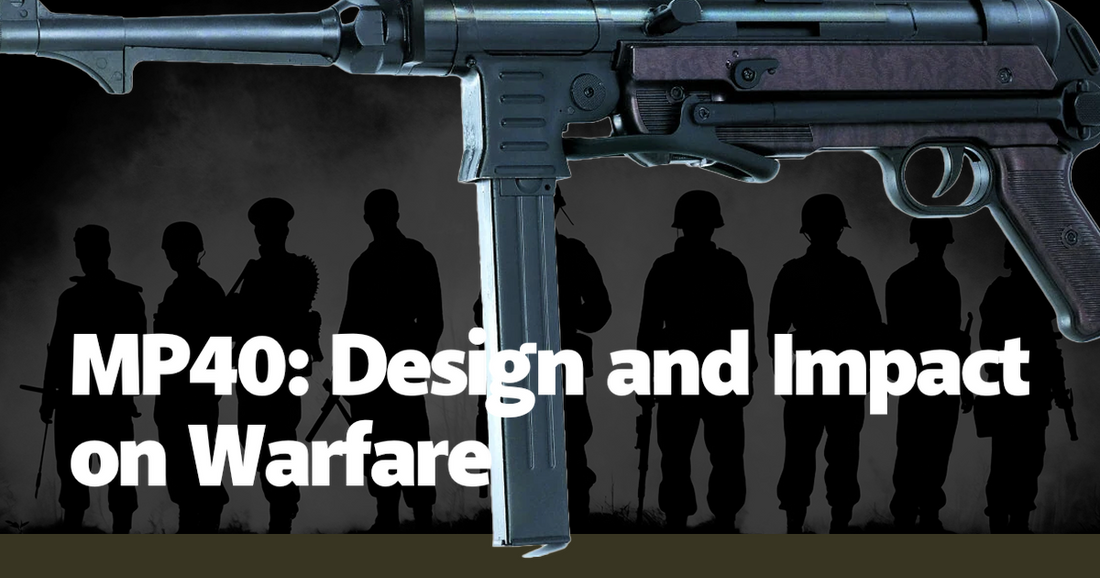The MP40, or Maschinenpistole 40, stands as one of the most iconic submachine guns of World War II, a weapon that not only revolutionized infantry tactics but also left an indelible mark on the history of warfare. Designed by Heinrich Vollmer in the late 1930s, the MP40 was a successor to the earlier MP38, incorporating several improvements that made it more robust and easier to mass-produce. The weapon's sleek, utilitarian design, characterized by its folding metal stock and minimalistic lines, was a stark departure from the wooden stocks and intricate mechanisms of earlier firearms. This simplicity was not just aesthetic but functional, allowing the MP40 to be produced quickly and maintained easily in the field.
The MP40's impact on warfare can be traced to its role in the German Blitzkrieg tactics—lightning-fast, highly mobile warfare that required weapons capable of delivering rapid, close-quarters firepower. The MP40's 9mm Parabellum cartridge, while not the most powerful round, was ideal for the close combat situations that German soldiers often found themselves in during urban battles and trench warfare. Its rate of fire, approximately 500-550 rounds per minute, allowed soldiers to lay down a withering hail of bullets, suppressing enemy positions and enabling rapid advances. This was particularly evident during the invasions of Poland and France, where German troops, armed with MP40s, overwhelmed Allied forces with their speed and ferocity.
One of the most compelling anecdotes illustrating the MP40's effectiveness comes from the Battle of Stalingrad, where German soldiers, entrenched in the brutal urban combat, relied heavily on the weapon. The MP40's compact size and folding stock made it ideal for the cramped, chaotic environments of the city's ruins. Soldiers could maneuver through the narrow, debris-filled streets and buildings, engaging Soviet troops at close range with deadly efficiency. The weapon's reliability in harsh conditions, from the freezing Russian winter to the dust and grime of battle, further cemented its reputation among the troops.
The design features of the MP40 were also a significant factor in its widespread use and effectiveness. The weapon's blowback-operated, open-bolt mechanism was simple yet reliable, reducing the likelihood of jams and malfunctions. Its magazine, holding 32 rounds, was double-stacked, allowing for more ammunition without significantly increasing the weapon's bulk. The folding stock, a novel feature at the time, provided stability for aiming while also allowing the weapon to be easily carried and deployed in tight spaces. These design elements combined to create a weapon that was both versatile and deadly, capable of adapting to a wide range of combat scenarios.
The MP40's influence extended beyond the German military, as captured weapons were often used by Allied forces and resistance fighters. The weapon's ease of use and maintenance made it a valuable asset for partisan groups operating behind enemy lines. Stories abound of French, Yugoslav, and Soviet partisans wielding MP40s in their guerrilla campaigns, using the weapon's firepower to ambush German patrols and disrupt supply lines. This widespread adoption by various forces attests to the MP40's effectiveness and the high regard in which it was held, even by those it was originally designed to fight against.
In the post-war period, the MP40 continued to see use in various conflicts around the world. Its robust design and availability made it a popular choice in the early stages of the Cold War, particularly in the hands of insurgent groups and newly-formed armies. The weapon's legacy can be seen in the design of later submachine guns, such as the Israeli Uzi and the American M3 Grease Gun, both of which drew inspiration from the MP40's simplicity and functionality. The MP40's design principles—reliability, ease of use, and adaptability—became the standard by which future submachine guns were judged.
The psychological impact of the MP40 on both its users and their enemies cannot be understated. For German soldiers, the weapon was a symbol of their military's technological superiority and tactical innovation. For their enemies, the distinctive sound of the MP40's rapid fire was a harbinger of the ferocity and relentlessness of the German assault. This psychological edge, combined with the weapon's physical capabilities, made the MP40 a formidable force on the battlefield. Its presence could demoralize enemy troops, giving German forces a crucial advantage in the heat of combat.
Today, the MP40 remains a subject of fascination for historians, military enthusiasts, and collectors. Its design and impact on warfare are studied in military academies around the world, serving as a case study in how technological innovation can influence tactics and outcomes in war. The weapon's enduring legacy is a testament to the ingenuity of its design and the pivotal role it played in one of the most significant conflicts in human history. The MP40 is more than just a weapon; it is a symbol of a bygone era, a reminder of the brutal efficiency of war, and a testament to the relentless march of military technology.

